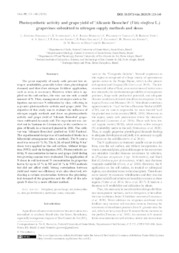Photosynthetic activity and grape yield of 'Alicante Bouschet' (Vitis vinifera L.) grapevines submitted to nitrogen supply methods and doses.
Photosynthetic activity and grape yield of 'Alicante Bouschet' (Vitis vinifera L.) grapevines submitted to nitrogen supply methods and doses.
Autoria: STEFANELLO, L. O.; SCHWALBERT, R.; MARQUES, A. C. R.; TAROUCO, C. P.; VITTO, B. B.; KRUG, A. V.; SANTOS, J. P. J. dos; GALARZA, B. P.; ZALAMENA, J.; SANTOS, H. P. dos; MELO, G. W. B. de; BRUNETTO, G.
Resumo: The great majority of sandy soils present low nitrogen availability, generally below vines physiological demand, and therefore nitrogen fertilizer application, such as urea, is necessary. However, when urea is applied on the soil surface, the vine can use only a small amount of N. Thus, management strategies such as fertigation can increase N utilization by vine, reflecting in a greater photosynthetic activity and grape yield. The objective of this study was to evaluate the influence of nitrogen supply methods and doses on photosynthetic activity and grape yield of 'Alicante Bouschet' grapevines cultivated in sandy soil. The experiment was carried out in Santana do Livramento, in the southern region of Brazil, in a vineyard planted in 2011. The cultivar was 'Alicante Bouschet' grafted on '1103 Paulsen'. The experimental design was of randomized blocks in a bifactorial arrangement (dose x method). The N source used was urea (45 % N). The 0, 20, 60 and 100 kg N·ha-1 doses were applied on the soil surface, without irrigation (NWI) and via fertigation (NF). Photosynthetic activity, N concentration in leaves and grape yield during two growing seasons were evaluated. The application of N doses in soil increased N concentration in grapevine leaves by up to 53 % in NF and 18 % in NWI methods but did not affect yield. Strong correlations between yield and water use efficiency were also observed, evidencing a certain synchronism between the physiological demand of the grapevine and the offer of the adequate N dose by a more efficient method.
Ano de publicação: 2020
Tipo de publicação: Artigo de periódico
Unidade: Embrapa Uva e Vinho
Palavras-chave: Fertigation, Gas exchange, Net Photosynthesis, Nitrogen Fertilization, Nutritional status, Vineyards
Observações
1 - Por padrão são exibidas publicações dos últimos 20 anos. Para encontrar publicações mais antigas, configure o filtro ano de publicação, colocando o ano a partir do qual você deseja encontrar publicações. O filtro está na coluna da esquerda na busca acima.
2 - Para ler algumas publicações da Embrapa (apenas as que estão em formato ePub), é necessário ter, no celular ou computador, um desses softwares gratuitos. Sistemas Android: Google Play Livros; IOS: iBooks; Windows e Linux: software Calibre.
Acesse outras publicações
Acesse a Base de Dados da Pesquisa Agropecuária (BDPA) para consultar o acervo completo das bibliotecas da Embrapa.

